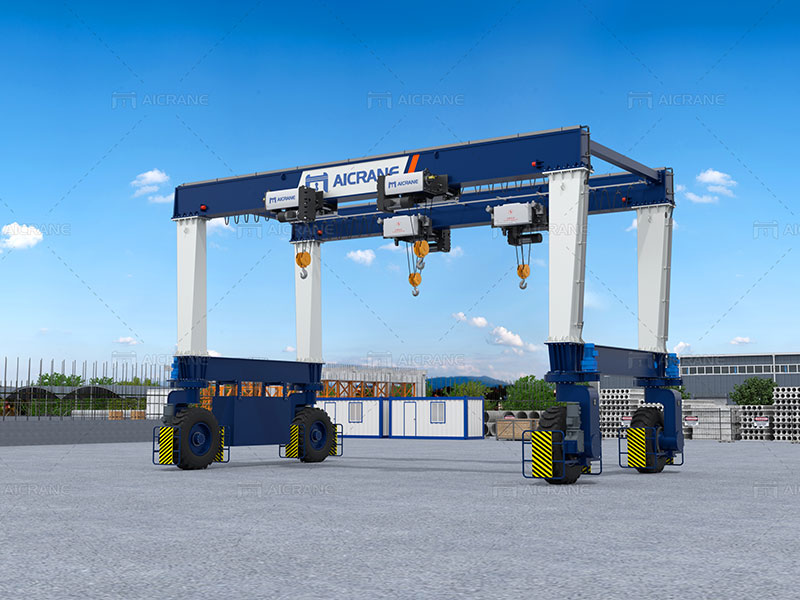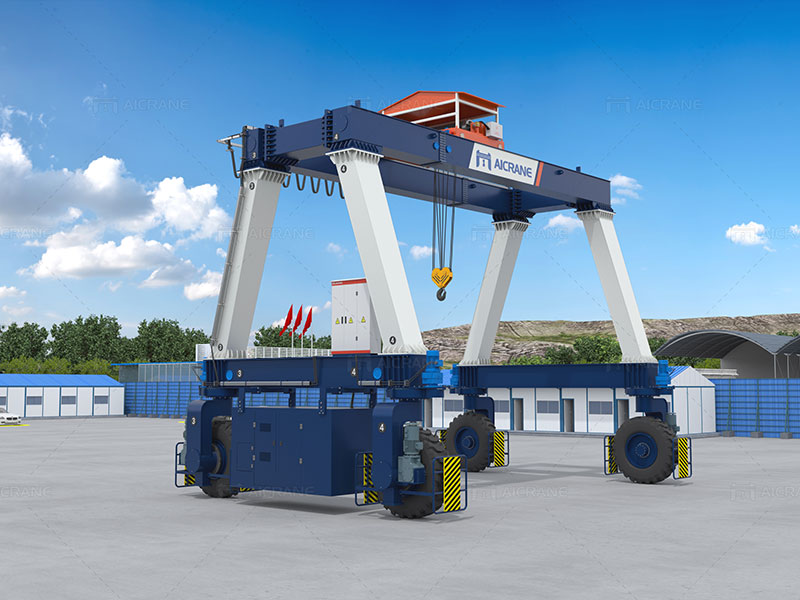Handling large and bulky loads in industrial environments requires specialized equipment designed to ensure safety, efficiency, and reliability. Rubber Tyred Gantry (RTG) cranes have become a popular choice for handling these loads, particularly in ports, rail yards, and heavy manufacturing facilities. RTG cranes offer mobility, flexibility, and substantial lifting capacity, making them suitable for various heavy-duty applications. However, ensuring the safe handling of large and bulky loads with RTG cranes requires careful planning, adherence to best practices, and proper equipment maintenance. This article explores key considerations and safety measures to follow when using rubber tyred gantry cranes for handling large and bulky loads.

Understanding Rubber Tyred Gantry Cranes
Rubber Tyred Gantry cranes are mobile cranes mounted on rubber tires, allowing them to move freely within a worksite without being confined to tracks. Unlike their rail-mounted counterparts, RTG cranes provide flexibility and maneuverability, making them suitable for areas where space constraints are a concern. They are commonly used in container terminals for stacking containers but are also ideal for handling various types of heavy and oversized loads, such as steel coils, precast concrete components, wind turbine parts, and more.
RTG cranes come in various sizes and capacities, typically ranging from 20 tons to over 100 tons. Their structure consists of a robust frame, a hoisting mechanism, a trolley that moves horizontally along the bridge, and a set of rubber tires for mobility. Some advanced mobile crane models are equipped with features such as anti-sway systems, load monitoring systems, and remote control operations, enhancing safety and operational efficiency.
Key Considerations for Safe Handling of Large and Bulky Loads
When using RTG cranes to handle large and bulky loads, operators must be aware of several key considerations to ensure safe operations:
- Understanding Load Characteristics: Before lifting any load, it is essential to understand its weight, dimensions, center of gravity, and material properties. This information helps determine the appropriate lifting equipment and method. For example, an unevenly distributed load may require a different lifting strategy than a uniformly distributed one. Additionally, knowing the load’s material properties ensures that it can withstand the forces applied during lifting.
- Choosing the Right Lifting Gear: Selecting the correct lifting gear, such as slings, hooks, and spreader bars, is crucial for safe load handling. The lifting gear must be rated for the load’s weight and size and be in good condition, free from wear and tear. For irregularly shaped or oversized loads, custom lifting beams or frames may be necessary to distribute the weight evenly and prevent damage to the load or the gantry crane.
- Conducting a Risk Assessment: Before starting any lifting operation, a comprehensive risk assessment should be conducted to identify potential hazards and implement control measures. Factors to consider include environmental conditions (e.g., wind speed, visibility), ground stability, load path, proximity to other equipment or structures, and potential interference with overhead power lines.
- Ensuring Proper Crane Positioning: Positioning the RTG crane correctly is vital for safe lifting. The crane should be positioned on a stable, level surface with adequate space for maneuvering. Operators must ensure that the crane’s tires are in good condition and inflated to the correct pressure to prevent tipping or instability during operation. Additionally, the load’s center of gravity should be directly beneath the hoist to minimize the risk of sway or imbalance.
- Implementing Safe Lifting Practices: Safe lifting practices are essential to prevent accidents and injuries. The operator must follow proper lifting techniques, such as lifting vertically and avoiding sudden jerks or swings. Gradual acceleration and deceleration of the hoist and trolley movements reduce the risk of load sway and ensure smoother operations. Using anti-sway technology, if available, can further enhance load stability during lifting and transport.

Best Practices for Operating Rubber Tyred Gantry Cranes
To handle large and bulky loads safely with RTG cranes, operators and site managers should follow these best practices:
- Pre-Operation Inspections: Conducting pre-operation inspections of the crane and lifting gear is a critical safety measure. Inspections should cover checking for any signs of wear, damage, or malfunction in the crane’s structure, tires, hydraulic systems, electrical systems, and lifting gear. Any defects should be addressed immediately before commencing operations.
- Operator Training and Certification: Only trained and certified operators should be allowed to operate RTG cranes. Operators must be familiar with the crane’s controls, safety features, and operational limits. Regular refresher training and assessments help ensure that operators stay updated with the latest safety practices and regulations.
- Using Load Monitoring Systems: Modern RTG cranes are equipped with load monitoring systems that provide real-time data on the weight of the load being lifted. These systems help prevent overloading and provide operators with accurate information to make informed decisions. Overloading the crane can lead to mechanical failures, tipping, or catastrophic accidents.
- Clear Communication and Coordination: Effective communication among all personnel involved in the lifting operation is essential for safety. Hand signals, radios, or headsets can be used to ensure clear and concise communication between the crane operator, signaler, and ground personnel. Coordination is particularly important when handling large loads that require multiple cranes or complex maneuvers.
- Maintaining Safe Work Areas: Keeping the work area clear of obstructions, unauthorized personnel, and unnecessary equipment reduces the risk of accidents. Barriers, warning signs, and designated walkways should be in place to keep people away from the crane’s operating zone. Additionally, lifting operations should be suspended during adverse weather conditions, such as high winds, rain, or poor visibility.
- Regular Maintenance and Inspections: Regular maintenance and inspections of RTG cranes are crucial to ensure their safe and reliable operation. Maintenance should include routine checks of the crane’s mechanical, electrical, and hydraulic systems, as well as the tires and lifting gear. Scheduled inspections by qualified personnel help identify potential issues early and prevent equipment failure during critical operations.
Safety Innovations and Advanced Features
To further enhance safety in handling large and bulky loads, Aicrane RTG cranes come equipped with advanced safety features. Some of these include:
- Anti-Sway Technology: Reduces the swinging of loads during lifting and transport, improving stability and control.
- Collision Avoidance Systems: Detects obstacles in the crane’s path and automatically stops the crane to prevent collisions.
- Remote Control Operations: Allows operators to control the crane from a safe distance, reducing the risk of accidents in hazardous environments.
- Emergency Stop Systems: Provides operators with the ability to quickly halt crane operations in case of an emergency.
Conclusion
Rubber Tyred Gantry cranes offer a versatile and efficient solution for handling large and bulky loads in various industrial settings. However, ensuring safety during these operations requires careful planning, proper equipment selection, operator training, and adherence to best practices. By following the guidelines outlined in this article, operators and site managers can minimize risks and ensure safe and efficient handling of large loads with RTG cranes. Prioritizing safety not only protects personnel and equipment but also enhances productivity and operational efficiency in the long run.